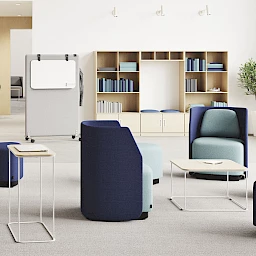A smart office that switches on the light when you enter, adjusts the temperature of work areas according to the preferences of the respective users and adapts the office furnishings individually to the personal body masses was still considered a vision of the future a few years ago. Today, smart offices are becoming more and more common in the world of work.
The working world is changing and with it the demands on offices. The trend is towards smart offices, modern workplaces that integrate intelligent technologies in buildings and room concepts and adapt flexibly to individual user needs. The networking of technical systems supports hybrid working models, enables more efficient work and facilitates everyday office life. In smart offices, building infrastructure and flexible physical space serve as a basis for creativity and support employees in accomplishing their business goals more effectively.
Flexibilisation of workspaces
The world of work is changing. Hybrid working and user-centricity have an impact on working hours, workplaces and corporate structures and require adapted spatial concepts. The flexibilisation of individual workspaces and the use of modular office components that can be reduced or enlarged as needed are being accompanied by an expansion of meeting and collaboration areas. Smart offices offer more space for exchange, project work, communication and support project-related work in the network with intelligent technology applications. Smart applications and modern communication technology enable collaboration across different workspaces.
Smart infrastructure and adaptable usage of spaces
Smart offices are based on a modern infrastructure that uses sensors to make data usable and working environment controllable. Smart office scenarios arise, for example, in the areas of lighting, noise intensity, temperature, air quality, movement and room occupancy. Various building services can be controlled as well as workplaces and meeting rooms can be booked via app. Smart technology permits customisable use of space. In smart offices, it is not only light and temperature that can be controlled on a person-specific basis. Smart office systems also recognise individual configurations of desks and office chairs and adapt them to the respective user. Almost incidentally, (anonymised) data about the use of rooms and individual furnishing zones can be collected as a basis for further optimisation processes.
Advantages of smart offices:
- Alignment of the workplace to the individual preferences of employees
- Increased well-being of employees
- Compliance to ergonomic standards
- Improved resources management
- Bookable building and work resources
- Ensuring safety aspects
Smart Office applications
Modern smart offices can be designed in different ways, with all-in-one systems or priority solutions. Today we will introduce you to some of them:
Booking and controlling spaces and other resources
Smart office apps enable joint user communication and provide important information for everyday work. In addition, resources such as workstations and meeting rooms can be booked via app. Sensors measure the current capacity utilisation and allow bookings in real time. Apps also enable access control to buildings via smartphone. Authorisation concepts are managed centrally. Building functions such as lighting, air conditioning and media technology can also be controlled via smart office apps.
Lockable storage modules
More and more employees are working in hybrid work models and only come into the office part-time. There, they often use flex or temporary workstations that they share with other colleagues. Smart locker cabinets and lockable storage modules provide storage space close to workstations that is needed for storing personal items and individual work equipment. Electronic RFID locks enable an intelligent, convenient management of the existing storage space systems.
Individual ergonomics
Ergonomic assistance systems ensure healthy working positions and customisable office furniture. For example, smart office applications provide user-specific lighting settings for desktop lighting or automatic adjustment of the preferred working height and sitting position. Digital assistants not only calculate optimal seating and standing positions. A reminder to change the working position is also integrated within modern smart office systems.
People, workplaces and technologies are important factors in smart offices. The office is increasingly becoming a place that connects people, spaces and infrastructure to create the best possible working conditions. Smart office applications can support the transformation process.






